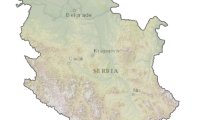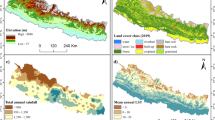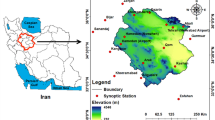Abstract
The estimation of spatiotemporal variability of vegetation health and associated climatic variables is a prerequisite for efficient management of mountain ecosystems. The present study aimed to quantify the changing effect of different climatic parameters on vegetation health in Khyber Pakhtunkhwa, Pakistan, from 2012 to 2021. The association between NDVI and three explanatory variables, i.e., temperature, precipitation, and wind speed, was analyzed using geostatistical model optimization and stationarity index analysis. Results showed that local model GWR presented optimal results owing to its ability to deal with spatial non-stationarity and stochasticity inherent in regression relationships. The most dominant climatic factor influencing vegetation dynamics in KPK was temperature, followed by wind speed and precipitation. However, there was a gradual decline in the influence of temperature in controlling vegetation dynamics after 2018, and precipitation emerged to be the major determinant. Moreover, the stationarity index was calculated at multi-scales to determine the operational scale range for each climatic variable. The scale-dependency of NDVI-T relationship exhibited highest spatial heterogeneity, up to a distance of 600 km. Overall, geostatistical modeling using earth observation datasets enabled insightful understanding of spatiotemporal variations in vegetation response to climate change, necessary for sustainable development and responsive climate action.










Similar content being viewed by others
Data availability
The datasets generated and/or analyzed during the current study are available from Google Earth Engine satellite data repository.
References
Afuye GA, Kalumba AM, Orimoloye IR (2021) Characterization of vegetation response to climate change: a review. Sustainability (Switzerland) 13(13). https://doi.org/10.3390/su13137265
Ali A, Ashraf MI, Gulzar S, Akmal M, Ahmad B (2020) Estimation of soil carbon pools in the forests of Khyber Pakhtunkhwa Province, Pakistan. J For Res (Harbin) 31:2313–2321. https://doi.org/10.1007/s11676-019-01059-9
Arshad M, Ma X, Yin J, Ullah W, Ali G, Ullah S, Liu M, Shahzaman M, Ullah I (2021) Evaluation of GPM-IMERG and TRMM-3B42 precipitation products over Pakistan. Atmos Res 249:105341. https://doi.org/10.1016/j.atmosres.2020.105341
Bell B, Hersbach H, Simmons A, Berrisford P, Dahlgren P, Horányi A, Muñoz-Sabater J, Nicolas J, Radu R, Schepers D, Soci C (2021) The ERA5 global reanalysis: preliminary extension to 1950. Q J Roy Meteorol Soc 147:4186–4227. https://doi.org/10.1002/qj.4174
Brunsdon C, Fotheringham AS, Charlton ME (1996) Geographically weighted regression: a method for exploring spatial nonstationarity. Encycl Geogr 28:281–298. https://doi.org/10.4135/9781412939591.n478
Cui L, Shi J (2010) Temporal and spatial response of vegetation NDVI to temperature and precipitation in eastern China. J Geogr Sci 20:163–176. https://doi.org/10.1007/s11442-010-0163-4
De Jong R, de Bruin S, de Wit A, Schaepman ME, Dent DL (2011) Analysis of monotonic greening and browning trends from global NDVI time-series. Remote Sens Environ 115:692–702. https://doi.org/10.1016/J.RSE.2010.10.011
de Jong R, Verbesselt J, Schaepman ME, de Bruin S (2012) Trend changes in global greening and browning: Contribution of short-term trends to longer-term change. Glob Chang Biol 18:642–655. https://doi.org/10.1111/j.1365-2486.2011.02578.x
Estrella EH, Stoeth A, Krakauer NY, Devineni N (2021) Quantifying vegetation response to environmental changes on the Galapagos Islands, Ecuador using the Normalized Difference Vegetation Index (NDVI). Environ Res Commun 3(6):065003. https://doi.org/10.1088/2515-7620/AC0BD1
Fattah MA, Morshed SR (2022) Assessment of the responses of spatiotemporal vegetation changes to climatic variability in Bangladesh. Theor Appl Climatol 148:285–301. https://doi.org/10.1007/s00704-022-03943-7
Fayech D, Tarhouni J (2021) Climate variability and its effect on normalized difference vegetation index (NDVI) using remote sensing in semi-arid area. Model Earth Syst Environ 7:1667–1682. https://doi.org/10.1007/s40808-020-00896-6
Fenetahun Y, Yong-Dong W, You Y, **nwen X (2020) Dynamics of forage and land cover changes in Teltele district of Borana rangelands, Southern Ethiopia: using geospatial and field survey data. BMC Ecol 20:1–16
Foody GM (2004) Spatial nonstationarity and scale-dependency in the relationship between species richness and environmental determinants for the sub-Saharan endemic avifauna. Glob Ecol Biogeogr 13:315–320
Fotheringham AS, Chris B, Martin C (2002) Geographically weighted regression: the analysis of spatially varying relationships
Gao J, Jiao K, Wu S (2019) Investigating the spatially heterogeneous relationships between climate factors and NDVI in China during 1982 to 2013. J Geogr Sci 29:1597–1609. https://doi.org/10.1007/s11442-019-1682-2
Georganos S, Abdi AM, Tenenbaum DE, Kalogirou S (2017) Examining the NDVI-rainfall relationship in the semi-arid Sahel using geographically weighted regression. J Arid Environ 146:64–74. https://doi.org/10.1016/J.JARIDENV.2017.06.004
Guan Q, Yang L, Guan W, Wang F, Liu Z, Xu C (2019) Assessing vegetation response to climatic variations and human activities: spatiotemporal NDVI variations in the Hexi Corridor and surrounding areas from 2000 to 2010. Theor Appl Climatol 135:1179–1193. https://doi.org/10.1007/s00704-018-2437-1
He B, Chen A, Wang H, Wang Q (2015) Dynamic response of satellite-derived vegetation growth to climate change in the three north shelter forest region in China. Remote Sens (Basel) 7:9998–10016. https://doi.org/10.3390/rs70809998
He P, Xu L, Liu Z, **g Y, Zhu W (2021) Dynamics of NDVI and its influencing factors in the Chinese Loess Plateau during 2002–2018. Reg Sustain 2:36–46. https://doi.org/10.1016/J.REGSUS.2021.01.002
Hooker J, Duveiller G, Cescatti A (2018) Data descriptor: A global dataset of air temperature derived from satellite remote sensing and weather stations. Sci Data 5(1):1–11. https://doi.org/10.1038/sdata.2018.246
Hussain SS, Hussain S, Hanif M (2013) Climate change scenarios and possible adaptation measures- Districts Chitral and DI Khan-Khyber Pakhtunkhwa
Jiangbo G, Kewei J, Shaohong W (2019) Investigating the spatially heterogeneous relationships between climate factors and NDVI in China during 1982 to 2013. J Geogr Sci 29:1597–1609
** K, Wang F, Li P (2018) Responses of vegetation cover to environmental change in large cities of China. Sustainability (Switzerland) 10(1):270. https://doi.org/10.3390/su10010270
Kashki A, Karami M, Zandi R, Roki Z (2021) Urban Climate Evaluation of the effect of geographical parameters on the formation of the land surface temperature by applying OLS and GWR , A case study Shiraz City, Iran. Urban Clim 37:100832. https://doi.org/10.1016/j.uclim.2021.100832
Khan N, Shah SJ, Rauf T, Zada M, Yukun C, Harbi J (2019) Socioeconomic impacts of the billion trees afforestation program in Khyber Pakhtunkhwa Province (KPK), Pakistan. Forests 10(8):703. https://doi.org/10.3390/f10080703
Khorrami B, Gunduz O (2021) Evaluation of the temporal variations of groundwater storage and its interactions with climatic variables using GRACE data and hydrological models: a study from Turkey. Hydrol Process 35(3):e14076. https://doi.org/10.1002/hyp.14076
Kim MK, Graefe D (2021) Geographically weighted regression to explore spatially varying relationships of recreation resource impacts: A case study from Adirondack Park, New York, USA. J Park Recreat Admi 39:43–63. https://doi.org/10.18666/JPRA-2020-10515
Li W, Chen S, Dong J, Wu J (2021) Exploring the spatial variations of transfer distances between dockless bike-sharing systems and metros. J Transp Geogr 92:103032. https://doi.org/10.1016/j.jtrangeo.2021.103032
Liu X, Tian Z, Zhang A, Zhao A, Liu H (2019) Impacts of climate on spatiotemporal variations in vegetation NDVI from 1982-2015 in Inner Mongolia, China. Sustainability (Switzerland) 11:2–22. https://doi.org/10.3390/su11030768
Liu Y, Tian J, Liu R, Ding L (2021) Influences of climate change and human activities on NDVI changes in china. Remote Sens (Basel) 13(21):4326. https://doi.org/10.3390/rs13214326
Mallick J, AlMesfer MK, Singh VP, Falqi II, Singh CK, Alsubih M, Kahla NB (2021) Evaluating the NDVI–rainfall relationship in Bisha watershed, Saudia Arabia using non-stationary modeling technique. Atmosphere 12:593. https://doi.org/10.3390/atmos12050593
Maxwell SK, Sylvester KM (2012) Identification of “ever-cropped” land (1984–2010) using Landsat annual maximum NDVI image composites: Southwestern Kansas case study. Remote Sens Environ 121:186–195. https://doi.org/10.1016/J.RSE.2012.01.022
McNally A, Arsenault K, Kumar S, Shukla S, Peterson P, Wang S, Funk C, Peters-Lidard CD, Verdin JP (2017) A land data assimilation system for sub-Saharan Africa food and water security applications. Sci Data 4(1):1–19. https://doi.org/10.1038/sdata.2017.12
Mumtaz F, Li J, Liu Q, Tariq A, Arshad A, Dong Y, Zhao J, Bashir B, Zhang H, Gu C, Liu C (2023) Impacts of green fraction changes on surface temperature and carbon emissions: comparison under forestation and urbanization resha** scenarios. Remote Sens (Basel) 15(3):859. https://doi.org/10.3390/rs15030859
Mumtaz F, Tao Y, de Leeuw G, Zhao L, Fan C, Elnashar A, Bashir B, Wang G, Li L, Naeem S, Arshad A (2020) Modeling spatio-temporal land transformation and its associated impacts on land surface temperature (LST). Remote Sens (Basel) 12(18):2987. https://doi.org/10.3390/RS12182987
Mussarat S, AbdEl-Salam NM, Tariq A, Wazir SM, Ullah R, Adnan M (2014) Use of ethnomedicinal plants by the people living around indus river. Evid Based Complement Alternat Med 2014. https://doi.org/10.1155/2014/212634
Pei F, Wu C, Liu X, Li X, Yang K, Zhou Y, Wang K, Xu L, **a G (2018) Monitoring the vegetation activity in China using vegetation health indices. Agric For Meteorol 248:215–227. https://doi.org/10.1016/J.AGRFORMET.2017.10.001
Pei Z, Fang S, Yang W, Wang L, Wu M, Zhang Q, Han W, Khoi DN (2019) The relationship between NDVI and climate factors at different monthly time scales: a case study of grasslands in inner Mongolia, China (1982-2015). Sustainability (Switzerland) 11(24):7243. https://doi.org/10.3390/su11247243
Prăvălie R, Sirodoev I, Nita IA, Patriche C, Dumitraşcu M, Roşca B, Tişcovschi A, Bandoc G, Săvulescu I, Mănoiu V, Birsan MV (2022) NDVI-based ecological dynamics of forest vegetation and its relationship to climate change in Romania during 1987–2018. Ecol Indic 136:108629. https://doi.org/10.1016/J.ECOLIND.2022.108629
Pu M, Zhao Y, Ni Z, Huang Z, Peng W, Zhou Y, Liu J, Gong Y (2022) Spatial-temporal evolution and driving forces of NDVI in China’s Giant Panda National Park. Int J Environ Res Public Health 19(11):6722. https://doi.org/10.3390/ijerph19116722
Qu S, Wang L, Lin A, Zhu H, Yuan M (2018) What drives the vegetation restoration in Yangtze River basin, China: Climate change or anthropogenic factors? Ecol Indic 90:438–450. https://doi.org/10.1016/J.ECOLIND.2018.03.029
Rabbia F, Bauerb S, Idalinyab J (2010) Contribution of forests to rural inequality reduction: present scope and future options for rural development and sustainable use of forests. Int J Sustain Dev World Ecol 17(1):4–14
Ren Y, Liu J, Liu S, Wang Z, Liu T, Shalamzari MJ (2022) Effects of climate change on vegetation growth in the Yellow River Basin from 2000 to 2019. Remote Sens (Basel) 14(3):687. https://doi.org/10.3390/rs14030687
Sarfaraz H, Khan AA, Javed N, Ahmad S, Rahim I, Rafique M (2016) Khyber Pakhtunkhwa biodiversity strategy and action plan. Islamabad: conservation and sustainable management of biodiversity in Khyber Pakhtunkhwa, Deutsche Gesellschaft für Internationale Zusammenarbeit (GIZ) GmbH
Sharma N, Kumar S (2021) Nitrogen transformation rates in the Himalayan soils at different temperature and elevation conditions. J Soil Sediment 21:13–26. https://doi.org/10.1007/s11368-020-02722-z/Published
Sharma Y, Ahmed R, Sajjad H (2022) Assessing vegetation condition across topography in Nainital district, India using temperature vegetation dryness index model. Model Earth Syst Environ 8:2167–2181. https://doi.org/10.1007/s40808-021-01208-2
Sun H, Wang J, **ong J, Bian J, ** H, Cheng W, Li A (2021) Vegetation change and its response to climate change in Yunnan Province, China. Adv Meteorol 2021:1–20. https://doi.org/10.1155/2021/8857589
Tao S, Kuang T, Peng W, Wang G (2020) Analyzing the spatio-temporal variation and drivers of NDVI in upper reaches of the Yangtze River from 2000 to 2015: A case study of Yibin City. Acta Ecol Sin 40:5029–5043
Vannoppen A, Gobin A (2022) Estimating yield from NDVI, weather data, and soil water depletion for sugar beet and potato in Northern Belgium. Water (Switzerland) 14:1–15. https://doi.org/10.3390/w14081188
Wang B, Xu G, Li P, Li Z, Zhang Y, Cheng Y, Jia L, Zhang J (2020) Vegetation dynamics and their relationships with climatic factors in the Qinling Mountains of China. Ecol Indic 108:105719. https://doi.org/10.1016/J.ECOLIND.2019.105719
Wang Q, Ni J, Tenhunen J (2005) Application of a geographically weighted regression analysis to estimate net primary production of Chinese forest ecosystems. Glob Ecol Biogeogr 14:379–393
Wang Y, Hou X, Wang M, Wu L, Ying L, Feng Y (2013) Topographic controls on vegetation index in a hilly landscape: a case study in the Jiaodong Peninsula, Eastern China. Environ Earth Sci 70:625–634. https://doi.org/10.1007/s12665-012-2146-5
Wei Q, Zhang L, Duan W (2019) Global and geographically and temporally weighted regression models for modeling PM 2.5 in Heilongjiang , China from 2015 to 2018. Int J Environ Res Public Health 16:5107
Wheeler D, Tiefelsdorf M (2005) Multicollinearity and correlation among local regression coefficients in geographically weighted regression. J Geogr Syst 7:161–187. https://doi.org/10.1007/s10109-005-0155-6
Yang L, Guan Q, Lin J, Tian J, Tan Z, Li H (2021) Evolution of NDVI secular trends and responses to climate change: a perspective from nonlinearity and nonstationarity characteristics. Remote Sens Environ 254:112247. https://doi.org/10.1016/J.RSE.2020.112247
Yang Y, Wang S, Bai X, Tan Q, Li Q, Wu L, Tian S, Hu Z, Li C, Deng Y (2019) Factors affecting long-term trends in global NDVI. Forests 10(5):372. https://doi.org/10.3390/f10050372
Zhan C, Liang C, Zhao L, Jiang S, Niu K, Zhang Y, Cheng L (2022) Vegetation dynamics and its response to climate change in the Yellow River Basin, China. Front Environ Sci 10(5):892747. https://doi.org/10.3389/fenvs.2022.892747
Zhang Y, He Y, Li Y, Jia L (2022) Spatiotemporal variation and driving forces of NDVI from 1982 to 2015 in the Qinba Mountains, China. Environ Sci Pollut Res 1–12. https://doi.org/10.1007/s11356-022-19502-6
Author information
Authors and Affiliations
Contributions
IB and FF have explored the idea, processed the data, wrote the manuscript, analyzed, and explained the results. KM has conceptualized, supervised, and reviewed the research. RF, SP, and FM have assessed and explained concepts related to forest/agriculture. SR has provided archaeological perspective of vegetation in the area.
Corresponding author
Ethics declarations
Ethics approval and consent to participate
All authors have read, understood, and have complied as applicable with the statement on “Ethical responsibilities of Authors” as found in the Instructions for Authors and are aware that with minor exceptions, no changes can be made to authorship once the paper is submitted.
Competing interests
The authors declare no competing interests.
Additional information
Publisher’s Note
Springer Nature remains neutral with regard to jurisdictional claims in published maps and institutional affiliations.
Supplementary information
ESM 1
(DOCX 219 kb)
Rights and permissions
Springer Nature or its licensor (e.g. a society or other partner) holds exclusive rights to this article under a publishing agreement with the author(s) or other rightsholder(s); author self-archiving of the accepted manuscript version of this article is solely governed by the terms of such publishing agreement and applicable law.
About this article
Cite this article
Basit, I., Faizi, F., Mahmood, K. et al. Assessment of vegetation dynamics under changed climate situation using geostatistical modeling. Theor Appl Climatol 155, 3371–3386 (2024). https://doi.org/10.1007/s00704-024-04840-x
Received:
Accepted:
Published:
Issue Date:
DOI: https://doi.org/10.1007/s00704-024-04840-x




